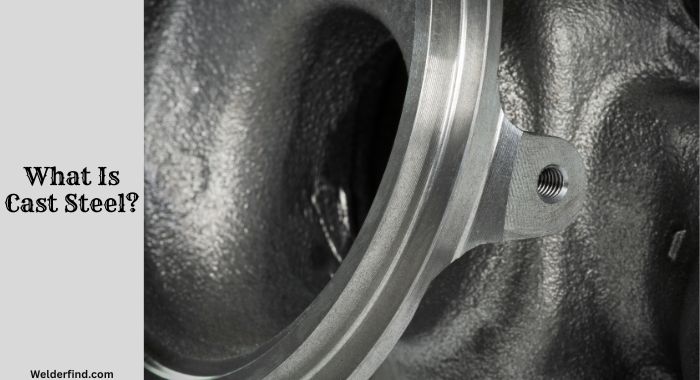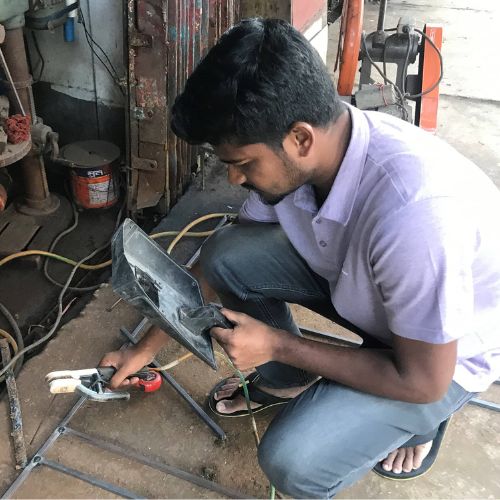TIG welding involves joining two pieces of metal together using a tungsten electrode in an electric arc. It’s a popular welding process for various materials.
One of them is cast steel, a metal cast into a specific shape and is usually used in applications that require a good level of strength and toughness.
TIG welding cast steel is a relatively straightforward process used in various industrial and hobbyist applications.
In this write-up, we’ll discuss the basics of TIG welding cast steel, including the process, tips, necessary supplies, and equipment.
So, let’s get right in.
What Is Cast Steel?

Cast steel is a metal that has been heated and poured into a mold. It is a solid, durable metal used in various applications, such as bridge construction, machine parts, and automotive parts.
Cast steel is a type of carbon steel combining iron and carbon. It is a strong, corrosion-resistant metal that can be made in numerous shapes and sizes.
The metal is made by melting it and pouring it into a mold. Once the metal cools and hardens, the mold is broken away, and the steel is ready for use.
Can You Weld Cast Steel With A TIG Welder?
You can weld cast steel with a TIG welder. However, it is essential to note that cast steel is harder to weld than other steel alloys, so you may need to use a low amperage setting and preheat the steel before welding.
Additionally, you may need to use a special filler rod designed for welding cast steel. Remember that cast steel requires more skill to weld than other steel alloys, so if you are a beginner welder, it is best to practice on other materials before attempting to weld cast steel.
What electrode to weld cast steel?
A nickel-based electrode is typically recommended for welding cast steel. However, it can be welded with various other electrodes, including low-alloy and stainless steel. Low-alloy electrodes have low hydrogen potential and can weld cast steel with good weldability.
Nickel electrodes have good thermal and electrical conductivity and can be used for welding cast steel with good weldability. Stainless steel electrodes are also used for welding cast steel.
These electrodes have excellent corrosion resistance and can be used with either AC or DC. They are usually used with reverse polarity.
How To TIG Welding Cast Steel?
Now, let’s see the step-by-step process of TIG welding cast steel:
Step-1: Prepare the materials
Firstly, ensure the area is clean and free of debris, and wear the appropriate welding gear, including a welding helmet and hand tig gloves.
Step-2: Fit the torch
Then fit the TIG torch to the welding machine and make sure all the connections are secure.
Step-3: Set the amperage
You have to set the amperage on the welding machine to the recommended level for the type of material. Using too much amperage can cause the cast steel to crack or break during the welding process.
Step-4: Fit the electrode
Now, fit the tungsten electrode into the torch and make sure it is properly seated.
Step-5: Shield the weld
Then insert a ceramic cup or other shielding gas into the torch and set the gas flow to the recommended level for the material and welding process.
Step-6: Start welding
Start welding the cast steel by pressing the trigger on the TIG torch and moving the electrode in a circular motion around the joint.
Step-7: Monitor the weld
Now you have to monitor the weld to make sure it is flowing correctly and not becoming too hot.
Step-8: Finish the weld
At this point, you will finish the weld by lifting the TIG torch from the joint, allowing the weld to cool.
Last Step: Clean the weld
Finally, clean the weld area with a wire brush or other appropriate tool to remove any slag or impurities.
TIG Welding Cast Steel Common Mistakes & How To Avoid Them
TIG welding cast steel can be challenging, as it is notoriously difficult to weld due to its high melting point and carbon content.
However, it is possible to successfully weld cast steel with the proper techniques. Let’s see some common mistakes to avoid when TIG welding cast steel.
Mistake 1: Not Using the Right Welding Rod
Solution: Using an appropriate welding rod for TIG welding cast steel is essential. These rods should have a high carbon content and withstand the high temperatures required to weld cast steel.
Mistake 2: Not Using an Appropriate Gas Mix
Solution: When welding cast steel, it is vital to use an appropriate gas mix for the application. An oxygen-argon mix is often recommended for TIG welding cast steel.
Mistake 3: Not Maintaining a Proper Welding Speed
Solution: When TIG welding cast steel, it is crucial to maintain a consistent welding speed. Too slow of a speed may result in incomplete fusion, and too fast of a speed may cause the weld to be too shallow.
Mistake 4: Not Using a Proper Shielding Gas
Solution: Shielding gas is necessary when TIG welding cast steel. Using an appropriate shielding gas is important to prevent oxidation and reduce the risk of porosity.
Mistake 5: Not Cleaning the Weld Area
Solution: It is essential to clean the weld area before welding to remove any contaminants. This helps to ensure that the weld is solid and free from defects.
Tips For TIG Welding Cast Steel
Here are some vital tips for TIG welding cast steel:
- Clean the joint area thoroughly with a wire brush to remove any dirt, rust, scale, or other contaminants that could interfere with the welding process.
- Choose a TIG welding machine capable of producing the amperage required for the thickness of the cast steel.
- Preheat the steel to 200°C to reduce the cooling rate and make the weld area more ductile.
- Use a back purge of argon gas to protect the backside of the weld from oxidation.
- Start the weld with a “drag” technique, using a long arc and slow travel speed.
Last Words
TIG welding cast steel can be a very effective and reliable way to join two metals together, as long as the proper techniques and materials are used.
You can also use it to repair existing cast steel components, saving time and money. However, remember that TIG welding requires a great deal of skill and experience.
FAQ
Is cast steel magnetic?
No, cast steel is not magnetic. Cast steel is an alloy made mostly of iron but contains other elements such as carbon, manganese, and silicon. The presence of these other elements reduces the magnetic properties of cast steel, making it non-magnetic.

Great post!
Cheers!
Greetings I am so thrilled I found your blog page, I really
found you by error, while I was looking on Google for something else, Nonetheless I am
here now and would just like to say thank you for
a marvelous post and a all round interesting blog (I also
love the theme/design), I don’t have time to go through it all at the minute but I have bookmarked it and also added in your RSS feeds, so when I
have time I will be back to read a lot more, Please do keep up the fantastic work.
Thanks and keep supporting.